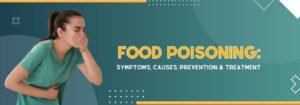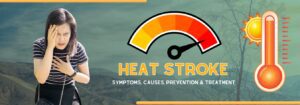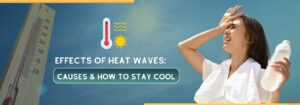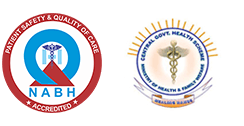Heat Stroke Symptoms, Prevention & Treatment
Heat stroke is a serious, life-threatening condition that occurs when the body’s temperature regulation fails, leading to an elevated core body temperature of 104°F (40°C) or higher. As we move into warmer months, it is crucial to understand the dangers of heat stroke, recognize its symptoms, know how to prevent it, and learn the immediate steps for treatment.
What is Heat Stroke?
Heat stroke is the most severe form of heat illness, characterized by a dramatic rise in body temperature due to prolonged exposure to high heat and humidity, often coupled with dehydration. It can affect anyone but is especially dangerous for young children, elderly individuals, and those with chronic illnesses.
Symptoms of Heat Stroke
Identifying heat stroke symptoms promptly can save lives. The hallmark symptoms include:
- High Body Temperature: A core body temperature of 104°F (40°C) or higher is the most significant sign.
- Altered Mental State or Behavior: Confusion, agitation, slurred speech, irritability, seizures, and in severe cases, coma.
- Nausea and Vomiting: The body’s attempt to cope with extreme heat stress.
- Flushed Skin: The skin may appear red and hot as the body overheats.
- Rapid Breathing and Heart Rate: The body’s response to high temperatures.
- Headache: A throbbing headache can occur as a result of excessive heat.
Causes of Heat Stroke
Heat stroke can be classified into two main types:
- Exertional Heat Stroke (EHS): Occurs in individuals performing strenuous activity in hot environments, commonly affecting athletes and laborers.
- Non-Exertional (Classic) Heat Stroke: Typically affects vulnerable populations such as the elderly, very young, and those with chronic health conditions during prolonged heat exposure.
Risk Factors for Heat Stroke
Several factors can increase the risk of heat stroke, including:
- Age: Infants and children up to four years old and adults over 65 are at higher risk due to their bodies’ reduced ability to regulate temperature.
- Health Conditions: Chronic illnesses such as heart disease, lung disease, and obesity.
- Medications: Certain drugs that affect the body’s ability to stay hydrated and respond to heat, such as diuretics, antihistamines, and antidepressants.
- Environmental Factors: High temperatures and humidity, especially when combined with poor ventilation.
- Physical Exertion in Hot Weather: Activities like exercise, sports, and outdoor labor in hot climates.
First Aid for Heat Stroke
Immediate action is crucial when heat stroke is suspected. Here are the steps to follow:
- Call Emergency Services: Heat stroke is a medical emergency requiring immediate attention.
- Move to a Cooler Environment: Transfer the person to a shaded or air-conditioned area.
- Cool the Person Down: Utilize the following methods to lower body temperature:
- Immersion in Cold Water: Place the person in a tub of cool water.
- Cooling Shower: Use a cool shower to reduce body temperature.
- Apply Ice Packs: Focus on the armpits, groin, neck, and back where blood vessels are close to the skin.
- Use Fans and Cool Air: Fan air over the person while wetting their skin with water.
Prevention of Heat Stroke
Preventing heat stroke involves proactive measures to avoid heat-related illnesses:
- Stay Hydrated: Drink plenty of fluids, and avoid beverages that can lead to dehydration, such as alcohol and caffeine.
- Wear Appropriate Clothing: Opt for lightweight, loose-fitting, and light-colored clothes.
- Plan Outdoor Activities Wisely: Schedule strenuous activities for cooler parts of the day, such as early morning or late evening.
- Acclimatize to the Heat: Gradually increase exposure to hot environments to build tolerance.
- Take Frequent Breaks: Rest in shaded or air-conditioned areas to cool down periodically.
- Use Sunscreen: Protect the skin from sunburn, which can impair the body’s ability to cool itself.
- Never Leave Anyone in a Parked Car: Temperatures can rise dramatically inside vehicles, posing a severe risk of heat stroke.
Understanding the Severity of Heat Stroke
Heat stroke can lead to severe complications, including:
- Organ Damage: Prolonged exposure to high temperatures can cause damage to vital organs, including the brain, heart, kidneys, and muscles.
- Permanent Disability: The longer treatment is delayed, the higher the risk of permanent damage.
- Death: Without prompt and effective treatment, heat stroke can be fatal.
Long-Term Management and Recovery
Recovery from heat stroke requires careful monitoring and sometimes extended medical care. Key steps in long-term management include:
- Continued Hydration: Ensuring adequate fluid intake during recovery.
- Avoiding Heat Exposure: Staying in cool environments and avoiding strenuous activities until fully recovered.
- Medical Follow-Up: Regular check-ups to monitor for any lasting effects on organ function.
Conclusion
Heat stroke is a critical condition that requires immediate medical intervention and proactive prevention strategies. Understanding the symptoms, causes, risk factors, and first aid measures can help protect yourself and others from the dangers of heat stroke. Stay informed, stay cool, and prioritize safety during hot weather to prevent this potentially fatal illness.
Heat Exhaustion Symptoms: Frequently Asked Questions (FAQs)
What are the first signs of heat exhaustion?
- The initial signs of heat exhaustion often include heavy sweating, weakness, fatigue, and muscle cramps. Individuals may also experience nausea, dizziness, and headaches.
Why does my face feel hot but not the rest of my body?
- Feeling hot in the face but not the rest of the body could be due to several factors, including increased blood flow to the face, skin sensitivity, or localized inflammation. It may also be a result of emotional stress or embarrassment.
Can sleep paralysis kill you?
- No, sleep paralysis itself is not fatal. It is a temporary inability to move or speak while falling asleep or waking up, often accompanied by hallucinations. Although frightening, sleep paralysis is not inherently life-threatening.
Why is my face red and warm but no fever?
- Facial redness and warmth without fever could be due to various reasons, such as flushing from emotional stress, alcohol consumption, spicy foods, or skin conditions like rosacea. It may also be a result of increased blood flow to the face due to physical exertion or hot weather.
What to wear in 80-degree weather?
- In 80-degree weather, it’s advisable to wear lightweight, breathable clothing made of natural fabrics like cotton or linen. Opt for loose-fitting clothes in light colors to help reflect sunlight and keep your body cool. Additionally, wearing a wide-brimmed hat and sunglasses can provide extra protection from the sun.
What are the key differences between heat exhaustion and heat stroke?
- Heat exhaustion and heat stroke are both heat-related illnesses, but they differ in severity. Heat exhaustion is characterized by heavy sweating, weakness, and nausea, while heat stroke is a medical emergency marked by a high body temperature, altered mental state, and potential organ damage. Heat stroke requires immediate medical attention, while heat exhaustion can often be managed with rest and hydration.
What are the best ways to prevent heat-related illnesses during hot weather?
- Preventive measures for heat-related illnesses include staying hydrated by drinking plenty of water, avoiding prolonged exposure to high temperatures, wearing lightweight and loose-fitting clothing, taking regular breaks in shaded or air-conditioned areas, and avoiding strenuous activities during the hottest parts of the day. It’s also essential to be aware of the signs of heat exhaustion and heat stroke and to seek medical help if needed.






